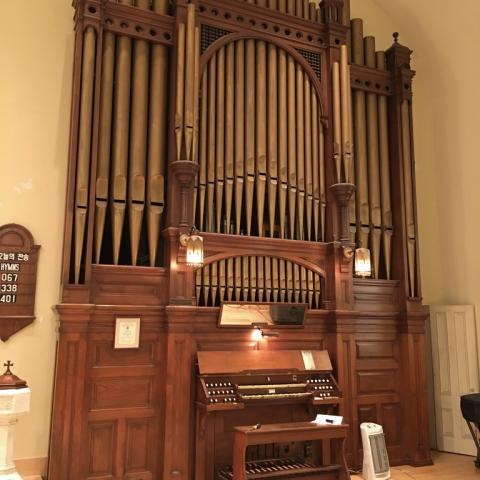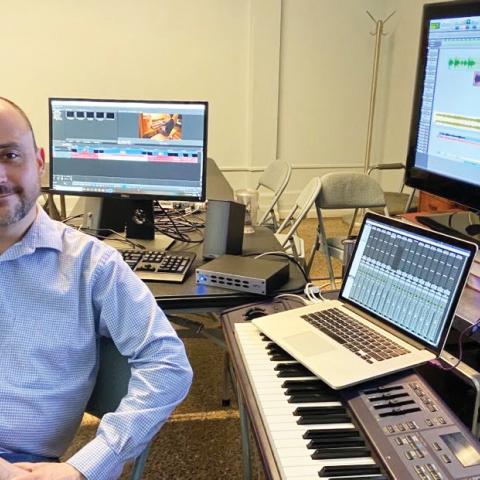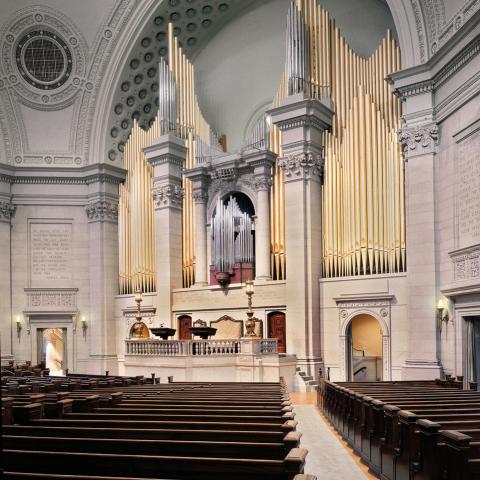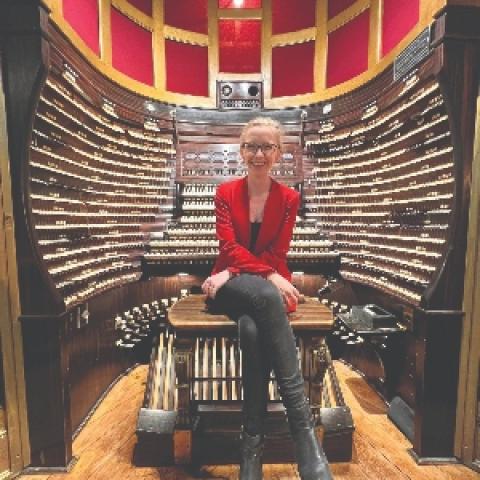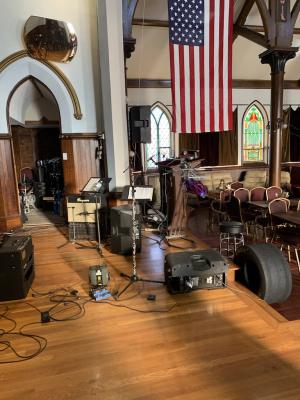
The human touch
Choral music is not one of life’s frills. It’s something that goes to the very heart of our humanity, our sense of community, and our souls. You express, when you sing, your soul in song. And when you get together with a group of other singers, it becomes more than the sum of the parts. All of those people are pouring out their hearts and souls in perfect harmony, which is kind of an emblem for what we need in the world, when so much of the world is at odds with itself. That’s just to express in symbolic terms what it’s like when human beings are in harmony. That’s a lesson for our times, and for all time.
When I was writing for the July 2015 issue of The Diapason, I was in the thrall of a video interview with John Rutter just released on YouTube by his American distributer, J. W. Pepper. (Type “john rutter the importance of choir” in the YouTube search bar.) This simple statement, presented as a matter of fact, says everything about why we work so hard to nurture parish choirs. Maybe not quite everything. He goes on,
Musical excellence is, of course, at the heart of it, but even if a choir is not the greatest in the world, it has a social value, a communal value . . . . [A] church or a school without a choir is like a body without a soul.
Recently, a blog post appeared on the website of the Episcopal Diocese of Dallas with the title, “The Future of the Organ for Church Worship,” written by the Reverend Marc Dobson. The piece opens with an overview of various chapters in the movement of contemporary music in worship including the Pentecostal movement, Folk Masses, Charismatic worship, television evangelists, and the Willow Creek movement. We are all well aware that many worshippers are moved by styles of music other than the organ-and-choir tradition in which I grew up. My first job playing the organ in church was in a Roman Catholic parish (I was thirteen years old) where the 5:00 Mass on Sunday afternoon featured folk music. I played traditional music on Sunday mornings on the Conn Artiste. (Get it?)
Fr. Dobson continues with other truths, such as, “Finding a good church organist is hard, given the nature of the church and where things are at today.” He states, fairly enough,
. . . many organists are not easily adaptable to a changing worship culture. Finding an organist who is willing to ‘give and take’ is certainly a challenge. Many organists are ‘purists’ when it comes to music, making the challenge even more difficult. They are Kings and Queens of their domain and will certainly let you know that very thing!
I have witnessed many musicians insisting that their way is correct, and I have participated in many dinner table conversations about working with difficult clergy. I know that what Fr. Dobson says here is based in truth. But when he continues by suggesting that if your church “finds itself without an organist,” a weekly subscription service, or “organ in a box,” is a viable solution, I think he has gone off the rails. Among advantages of this plan, he lists, “Pastoral control over weekly content,” “Accurate and professional sounding organ led worship,” and “Reliability.” These ideas carry negative connotations for organists, especially when taken out of context. In that light, it is important to mention that Fr. Dobson implies that he would prefer to have a “real” organist: “While it’s great to have a real organist, like I said, they’re not easy to find.” Fake organists need not apply.
§
Wendy and I moved to New York City four years ago, but I still have quite a few organ-service clients in the Boston area where I have been maintaining organs since 1984—I have been visiting eight of those organs for all that time. Thirty-five years is more than a generation, and I have seen many changes. I remember a formidable list of musicians who occupied the great organ benches of Boston, like George Faxon, John Ferris, Max Miller, Yuko Hayashi, Donald Teeters, and Daniel Pinkham, now all deceased; each led brilliant music programs and influenced the generation that followed them. University organ departments, notably the New England Conservatory of Music, fed churches with energetic ambitious young organists, many of whom are now the senior musicians in the area.
Unfortunately, NEC has closed its organ department, and perhaps not coincidentally, many of the churches where I maintain organs struggle to retain organists. More than a few congregations that I served and admired have disbanded, and quite a few of my clients have informed me that they will stop maintaining their organ because they have not been able to find an organist. I often learn that when the prominent incumbent musician retired, the church advertised the position at a lower salary, believing that such a transition was a good time to cut the budget. The next generation of organists, eager to apply for that plumb position, is disappointed to learn that the salary offered is low and moves on to the next opportunity.
Another symptom of a church that is cutting budgets is the unattended office. Thirty years ago, it was typical for every church to have at least one full-time person in the office. Of course, those were also the days before voicemail, call waiting, call forwarding, and all the technological advances that allow us to stay in touch without answering the phone. But today, at least where I live and work, when calling a church office, there is someone in the office only two or three mornings a week, so it is usual to reach a voicemail system. Scheduling a tuning visit and being sure that the heat will be turned up is done by voicemail, email, and text messages. In some ways, that is the same as replacing the organist with a subscription service, as in both cases the personal connection is removed from the equation.
I have been in countless church buildings where the ubiquitous church secretary ran an important ministry that was the bustling, cheerful, comforting traffic of parishioners coming and going during the week. The coffee was never very good, but there was always a bowl of candies or a plate of cookies and plenty of good cheer. It is a little sad for the organ tuner to open the building with his own key and walk alone down dark corridors past bulletin boards festooned with yellowing minutes of meetings held four months ago, and it is frustrating to find that in spite of numerous emails and voice messages, they failed to turn up the heat—again. It is especially sad in those buildings where I remember the bustle and conviviality of a rollicking church office, where running jokes lasted from year to year.
§
I’ll do my best to shine a positive light on Fr. Dobson’s blog and read it as a plea for good organists rather than a plan to replace them. Every good organist deserves a proper position, and every church that wants a good organist deserves to have one. However, there are some ground rules. The musicians and the clergy all must strive to be creative colleagues and constructive leaders in the life of the church, not the “King or Queen” of impregnable domains. And just as clergy should be well compensated, the church must offer reasonable compensation to the musician that reflects the requisite education and experience. Good organists are trained seriously and creatively. Planning a vibrant and varied music program requires deep knowledge of the literature and lots of skill, and church organists are among the most prolific of performing musicians, often playing fifteen or twenty different “numbers” before the public each week.
In many parishes, the choir (or choirs) is the most active volunteer activity. Dozens of people arrive cheerfully twice a week to give their effort and talents to the enhancement of worship. There are choir parties, retreats, and special programs of outreach to members who are suffering illness in their families or other of life’s complications. Some parish choirs even go on international tours, carrying the ministries of a local parish across oceans to sing in European cathedrals. To sustain all this excitement, it is the responsibility of the choir director to program music that is stimulating and challenging. Squandering that powerful volunteer effort by wasting hours is unthinkable. It is impossible to imagine any or all of this being replaced with a subscription service.
The important thing here is that we are all working for institutions that are not as strong as they were a generation ago. The musician who fails to be a constructive colleague is hastening the day when another good position vanishes.
§
I admit freely that I have heard very little contemporary worship music, and none of what I have heard merits much praise. I have never gone out of my way to hear it. My only exposures have been the several occasions when I have been working in an organ through a Saturday afternoon, agreeing that the praise band can rehearse while I am there. I have heard young volunteers with powerful amplifiers, no ears, no skill, and no sense of trying to improve plodding through four-chord, four-note, four-word songs over and over, making the same mistakes each time. (Just keep turning leather nuts, John.) I am sure there are skilled professional ensembles that lead contemporary music in worship, but I have not had an opportunity to witness in person.
If a parish judges that their congregation would thrive on a diet of contemporary music, wouldn’t it be appropriate for it to be offered with the highest professionalism possible, rather than allow it to serve as an excuse not to pay musicians? Joseph W. Clokey (1890–1960), professor of organ at Miami University and Pomona College and dean of the School of the Fine Arts at Miami University, said:
The purpose of worship is to elevate, not degrade. The quality of music used should be above, not below the cultural level of the congregation. If the music seems to be ‘over your heads’ the best plan is to raise your head.
I have had another experience with the diminution of excellence. A member of the clergy on staff with me did not approve of my assigning solos to members of the youth choir, saying that it was not fair to kids of lesser ability. I understand that kids do not want to be left out, but didn’t Aretha Franklin, Whitney Houston, Leontyne Price, and Jessye Norman all start their singing careers in church choirs? Would their artistry have thrived if they were held back to be like the others? Isn’t a church choir a good place to encourage natural talents? And isn’t it a responsibility of the choir director to recognize and encourage extraordinary abilities?
I know that I have always been involved with skillful church musicians; I am grateful for that. When I was directing choirs, it was my privilege to work with talented and dedicated singers, both volunteer amateurs and hired professionals, who were willing to work hard and who were excited each time by the challenge of learning a new piece. I also know that many churches present more modest music programs, but unless they are really horrible, the human element will always bring depth and warmth to the music.
Besides working with choirs to present music during regular worship, the church musician can fulfill another important pastoral role: working with families to plan music in times of joy and sorrow. Among the odd collection of memorabilia that has collected in the top drawers of my dresser is a note of appreciation I received from a couple a few days after I met with them to plan the music for their wedding. It is written in a childish hand with several strangely placed commas and misspelled words, but it simply thanks me for being nice and helping them to choose such nice music. They were certain that their wedding would be wonderful. Maybe it was a simple service with another round of Wagner, Pachelbel, and Mendelssohn. Maybe it was bit of a bore for me. But it was an important day for them, and they had the chance to choose special music for themselves. It might be the only time in their lives that they chose music for a celebration. I am happy that I had the chance to provide that for them. Sure, someone could have played recordings of the same pieces, but it would not be the same.
The last church I served had a traditional “chancel plan,” with the organ console on the right side. There was a door behind the bench that opened into the stairway to the choir room below, and it was usual for the groom and best man to hang out there waiting for the processional march. While playing preludes for the wedding of two beloved children of the parish (the bride had babysat for our kids), the groom was standing by the open door, marveling at the organ. I remember hearing him say to his best man, “we should let him ply his trade,” as he quietly closed the door. No subscription service could have done all that.
§
Allow me a sassy moment. If an organist can be replaced by a subscription service, so can a pastor. I bet I could find a service that would provide recorded sermons based on the lectionary, as if preaching was all the pastor did. And CDs are so yesterday. Each week you would receive an email with a WAV file to download. The laptop or tablet would feed Bluetooth speakers, and Bob’s your uncle.
But that is not the point. In response to Fr. Dobson’s essay, I would like to remind all of us that, at best, the church musician is called to the work in ways comparable to a call to join the clergy. Musicians get specialized educations, they practice many hours each week to maintain and hone their skills and to learn new literature, they read and study to keep current with new trends and styles, and with the work of serious new composers. Church musicians add life and color to worship, from mystery to majesty. They can inspire awe and wonder or interject a touch of humor. A huge proportion of the history of the fine arts has been devoted to public worship, from soaring architecture to the great settings of the Latin Mass, and from pictorial art to ecclesiastical symbolism.
Remember those words of Joseph W. Clokey, “The purpose of worship is to elevate, not degrade.” And remember the words of John Rutter, “. . . a church or school without a choir is like a body without a soul.”
I am thinking and writing about the best of things. Not all church musicians have conservatory degrees. Not all churches can afford or produce sophisticated music programs. But clergy and musicians should always be ready to work with each other and respect each other, to create constructive environments without animosity, envy, or competition, and to present a unified worship experience for the benefit and betterment of the communities in which they work.
Musicians, live up to the challenge! Raise the bar, work toward the best. Work to be sure you are a valued colleague and a valued part of staff. Would that it could be that no member of the clergy could feel that the local musician was overlord of an impregnable domain. You will be the one who is always offered a job.
Note: I contacted the communications director of the Episcopal Diocese of Dallas to ask why Fr. Dobson’s blog post had been removed. I was told that they received many responses in a short period and did not have a mechanism through which to make it be a discussion. ν


